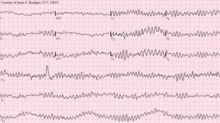| Sudden arrhythmic death syndrome | |
|---|---|
| Other names | Sudden adult death syndrome (SADS), bed death, sudden unexpected/unexplained death syndrome (SUDS), sudden unexpected/unexplained nocturnal death syndrome (SUNDS), Sudden Death Syndrome, Sudden Death, Delayed Death |
 | |
| A type of a deadly ventricular arrhythmia - Ventricular fibrillation pattern seen on an ECG | |
| Specialty | Cardiology |
| Causes |
|
| Risk factors | Family history of heart disease,[1] Asian ancestry,[2] Primary arrhythmia, atherosclerosis,[3] type 1 diabetes[4] |
| Frequency | 14.9 per 100,000 people in Japan 110.8 per 100,000 people in United States[5] |
Sudden arrhythmic death syndrome (SADS) is a sudden unexpected death of adolescents and adults caused by a cardiac arrest. However, the exact cause of the cardiac arrest, and thus the exact cause of death, is unknown. These deaths occur mainly during sleep or at rest.[6] One type of conduction defect known as Brugada syndrome can be responsible.[7][8]
The syndrome is rare in most areas around the world but occurs in populations that are culturally and genetically distinct. It was first noted in 1977 among southeast Asian Hmong refugees in the United States and Canada.[9][10] The syndrome was again noted in Singapore when a retrospective review of records showed that 230 otherwise healthy Thai foreign workers living in Singapore died suddenly of unexplained causes between 1982 and 1990.[11]
- ^ Cite error: The named reference
behrwas invoked but never defined (see the help page). - ^ Cite error: The named reference
mungerwas invoked but never defined (see the help page). - ^ Cite error: The named reference
Eckart 1254–1261was invoked but never defined (see the help page). - ^ Cite error: The named reference
diabeteswas invoked but never defined (see the help page). - ^ Yuan, David; Raju, Hariharan (12 September 2019). "Spotlight on sudden arrhythmic death syndrome". Research Reports in Clinical Cardiology. 10: 57–66. doi:10.2147/RRCC.S187480. S2CID 203506307.
- ^ Also known as SUDS. See: Reddy PR, Reinier K, Singh T, Mariani R, Gunson K, Jui J, Chugh SS. Physical activity as a trigger of sudden cardiac arrest: The Oregon Sudden Unexpected Death Study. Int J Cardiol. 2008
- ^ "Brugada Syndrome". NORD (National Organization for Rare Disorders). 2016. Retrieved 28 October 2017.
- ^ "Brugada syndrome". Genetics Home Reference. Retrieved 28 October 2017.
- ^ Centers for Disease Control (CDC) (1981). "Sudden, unexpected, nocturnal deaths among Southeast Asian refugees". MMWR. Morbidity and Mortality Weekly Report. 30 (47): 581–589. PMID 6796814.
- ^ Parrish RG, Tucker M, Ing R, Encarnacion C, Eberhardt M (1987). "Sudden unexplained death syndrome in Southeast Asian refugees: a review of CDC surveillance". MMWR Surveillance Summaries. 36 (1): 43SS–53SS. PMID 3110586.
- ^ Goh KT, Chao TC, Chew CH (1990). "Sudden nocturnal deaths among Thai construction workers in Singapore". Lancet. 335 (8698): 1154. doi:10.1016/0140-6736(90)91153-2. PMID 1971883. S2CID 46669256.